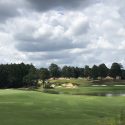 PGA Championship’s 10 most intriguing tee times, ranked
PGA Championship’s 10 most intriguing tee times, ranked
Inside the course making this week’s U.S. Amateur at Pinehurst so different
There would be no overshadowing Pinehurst No. 2 — designer Gil Hanse knew that as well as anyone — but there was a chance to improve the course next to it. In charge of the restoration of Pinehurst No. 4 in 2017, Hanse aimed to take to No. 4 some of the elements that make No. 2 one of the most revered courses in the world and add some modern touches.
“Our thought was, ‘Listen, let’s just build a golf course that feels like it belongs sitting next to No. 2,’” Hanse said at a preview event last month.
This week, Pinehurst No. 4 will get its formal introduction to the golf world as one of the host courses of a U.S. Amateur with a unique twist. For the first time, the final match of the match-play portion of the competition will be conducted over two different courses. It will commence with 18 holes on No. 4 before moving to No. 2 for the grand finale.
“I think it might be a little bit more interesting for the players — going through all those rounds of match play on the same course and then suddenly you get to kind of experience something from earlier in the week,” said Brandon Wu, the 7th-ranked amateur in the world. “Thirty-six hole days can be kind of a tough stretch for players, and I think it’ll be quite interesting to have different holes.”
The return to Pinehurst marks the third-ever U.S. Amateur played at the famed North Carolina resort and the first since 2008, when Danny Lee took home the title. Pinehurst also played host to the first ever U.S. Amateur in 1962, a victory for a little-know 20-year old named Labron Harris Jr., who had never seen the course before that week. Several competitors will look to do the same with this week.
“It’s quite a coming out party for our golf course,” Hanse said. “Obviously it’ll be the second course in hosting the stroke-play rounds to qualify for match play. But then to have it front and center in an historic pairing of two golf courses has never happened before, is quite an honor and a tribute to what we were able to accomplish in a very short period of time.”
When Hanse speaks, you can practically see the gears turning in his head, recalling the machinations of how the new-look No. 4 came to be. He recalls a day during the renovation when he walked through No. 2 to get to No. 4, and the transition from one course to the next finally felt organic. No. 4 couldn’t be No. 2, but he knew then that it would be a fantastic complement.
ADVERTISEMENT
No. 4 doesn’t have the same trademark crowned greens and run-off areas as No. 2, but it does have other charms. It plays a tad shorter, at 7,227 yards compared to No. 2’s 7,555. Hanse said that caddies have relayed to him that most average golfers find No. 4 more forgiving, but that better players deem it more difficult to score on — music to a course designer’s ears.
“It’s a great test for us, because these guys hit it as long as anybody — in fact, longer than the touring pros,” Hanse said. “In this day and age when you’re trying to combat not only the talent level of the golfers, but also the technology that they have, how do we build a golf course that will stand up to that?”
Hanse predicted that the weather will play a major role in whether No. 4 will provide that same stern test. “If we get firm and fast conditions, there will be a lot of subtleties and nuances that’ll come out of Course 4,” he said. “If it’s wet, they’ll be throwing darts out there.”
The field for the event includes 49 of the top 50 amateurs in the world. The who’s-who of young talent includes Cole Hammer, the world’s top-ranked amateur; Akshay Bhatia (No. 2); and Australian David Micheluzzi (No. 3). The Amateur also figures to help decide the U.S. Walker Cup team — set to compete Sept. 7-8 at Royal Liverpool — with Hammer, Bhatia and Stewart Hagestad already named to the team.
The field will start at 312 players and be reduced to 64 after two rounds of stroke play, one on each course. Then, the remaining group will play six rounds of match play, culminating in the historic championship round, against the backdrop of one of America’s golfing holy lands.
“It’s not one of, it’s the most historic place in American golf, and as far as public access and just the history of the whole resort, and what it means to American golf,” Hanse said. “So to welcome back the U.S. Amateur, I think it feels natural.”

ADVERTISEMENT






